Ye Bai
Discrete Minds in a Continuous World: Do Language Models Know Time Passes?
Jun 06, 2025



Abstract:While Large Language Models (LLMs) excel at temporal reasoning tasks like event ordering and duration estimation, their ability to perceive the actual passage of time remains unexplored. We investigate whether LLMs perceive the passage of time and adapt their decision-making accordingly through three complementary experiments. First, we introduce the Token-Time Hypothesis, positing that LLMs can map discrete token counts to continuous wall-clock time, and validate this through a dialogue duration judgment task. Second, we demonstrate that LLMs could use this awareness to adapt their response length while maintaining accuracy when users express urgency in question answering tasks. Finally, we develop BombRush, an interactive navigation challenge that examines how LLMs modify behavior under progressive time pressure in dynamic environments. Our findings indicate that LLMs possess certain awareness of time passage, enabling them to bridge discrete linguistic tokens and continuous physical time, though this capability varies with model size and reasoning abilities. This work establishes a theoretical foundation for enhancing temporal awareness in LLMs for time-sensitive applications.
MAPLE: Multi-Agent Adaptive Planning with Long-Term Memory for Table Reasoning
Jun 06, 2025Abstract:Table-based question answering requires complex reasoning capabilities that current LLMs struggle to achieve with single-pass inference. Existing approaches, such as Chain-of-Thought reasoning and question decomposition, lack error detection mechanisms and discard problem-solving experiences, contrasting sharply with how humans tackle such problems. In this paper, we propose MAPLE (Multi-agent Adaptive Planning with Long-term mEmory), a novel framework that mimics human problem-solving through specialized cognitive agents working in a feedback-driven loop. MAPLE integrates 4 key components: (1) a Solver using the ReAct paradigm for reasoning, (2) a Checker for answer verification, (3) a Reflector for error diagnosis and strategy correction, and (4) an Archiver managing long-term memory for experience reuse and evolution. Experiments on WiKiTQ and TabFact demonstrate significant improvements over existing methods, achieving state-of-the-art performance across multiple LLM backbones.
SpeechDialogueFactory: Generating High-Quality Speech Dialogue Data to Accelerate Your Speech-LLM Development
Mar 31, 2025Abstract:High-quality speech dialogue datasets are crucial for Speech-LLM development, yet existing acquisition methods face significant limitations. Human recordings incur high costs and privacy concerns, while synthetic approaches often lack conversational authenticity. To address these challenges, we introduce \textsc{SpeechDialogueFactory}, a production-ready framework for generating natural speech dialogues efficiently. Our solution employs a comprehensive pipeline including metadata generation, dialogue scripting, paralinguistic-enriched utterance simulation, and natural speech synthesis with voice cloning. Additionally, the system provides an interactive UI for detailed sample inspection and a high-throughput batch synthesis mode. Evaluations show that dialogues generated by our system achieve a quality comparable to human recordings while significantly reducing production costs. We release our work as an open-source toolkit, alongside example datasets available in English and Chinese, empowering researchers and developers in Speech-LLM research and development.
NEST-RQ: Next Token Prediction for Speech Self-Supervised Pre-Training
Sep 13, 2024



Abstract:Speech self-supervised pre-training can effectively improve the performance of downstream tasks. However, previous self-supervised learning (SSL) methods for speech, such as HuBERT and BEST-RQ, focus on utilizing non-causal encoders with bidirectional context, and lack sufficient support for downstream streaming models. To address this issue, we introduce the next token prediction based speech pre-training method with random-projection quantizer (NEST-RQ). NEST-RQ employs causal encoders with only left context and uses next token prediction (NTP) as the training task. On the large-scale dataset, compared to BEST-RQ, the proposed NEST-RQ achieves comparable performance on non-streaming automatic speech recognition (ASR) and better performance on streaming ASR. We also conduct analytical experiments in terms of the future context size of streaming ASR, the codebook quality of SSL and the model size of the encoder. In summary, the paper demonstrates the feasibility of the NTP in speech SSL and provides empirical evidence and insights for speech SSL research.
Seed-Music: A Unified Framework for High Quality and Controlled Music Generation
Sep 13, 2024



Abstract:We introduce Seed-Music, a suite of music generation systems capable of producing high-quality music with fine-grained style control. Our unified framework leverages both auto-regressive language modeling and diffusion approaches to support two key music creation workflows: \textit{controlled music generation} and \textit{post-production editing}. For controlled music generation, our system enables vocal music generation with performance controls from multi-modal inputs, including style descriptions, audio references, musical scores, and voice prompts. For post-production editing, it offers interactive tools for editing lyrics and vocal melodies directly in the generated audio. We encourage readers to listen to demo audio examples at https://team.doubao.com/seed-music .
Seed-ASR: Understanding Diverse Speech and Contexts with LLM-based Speech Recognition
Jul 05, 2024



Abstract:Modern automatic speech recognition (ASR) model is required to accurately transcribe diverse speech signals (from different domains, languages, accents, etc) given the specific contextual information in various application scenarios. Classic end-to-end models fused with extra language models perform well, but mainly in data matching scenarios and are gradually approaching a bottleneck. In this work, we introduce Seed-ASR, a large language model (LLM) based speech recognition model. Seed-ASR is developed based on the framework of audio conditioned LLM (AcLLM), leveraging the capabilities of LLMs by inputting continuous speech representations together with contextual information into the LLM. Through stage-wise large-scale training and the elicitation of context-aware capabilities in LLM, Seed-ASR demonstrates significant improvement over end-to-end models on comprehensive evaluation sets, including multiple domains, accents/dialects and languages. Additionally, Seed-ASR can be further deployed to support specific needs in various scenarios without requiring extra language models. Compared to recently released large ASR models, Seed-ASR achieves 10%-40% reduction in word (or character, for Chinese) error rates on Chinese and English public test sets, further demonstrating its powerful performance.
TraceableSpeech: Towards Proactively Traceable Text-to-Speech with Watermarking
Jun 07, 2024



Abstract:Various threats posed by the progress in text-to-speech (TTS) have prompted the need to reliably trace synthesized speech. However, contemporary approaches to this task involve adding watermarks to the audio separately after generation, a process that hurts both speech quality and watermark imperceptibility. In addition, these approaches are limited in robustness and flexibility. To address these problems, we propose TraceableSpeech, a novel TTS model that directly generates watermarked speech, improving watermark imperceptibility and speech quality. Furthermore, We design the frame-wise imprinting and extraction of watermarks, achieving higher robustness against resplicing attacks and temporal flexibility in operation. Experimental results show that TraceableSpeech outperforms the strong baseline where VALL-E or HiFicodec individually uses WavMark in watermark imperceptibility, speech quality and resilience against resplicing attacks. It also can apply to speech of various durations.
Jointly Recognizing Speech and Singing Voices Based on Multi-Task Audio Source Separation
Apr 17, 2024Abstract:In short video and live broadcasts, speech, singing voice, and background music often overlap and obscure each other. This complexity creates difficulties in structuring and recognizing the audio content, which may impair subsequent ASR and music understanding applications. This paper proposes a multi-task audio source separation (MTASS) based ASR model called JRSV, which Jointly Recognizes Speech and singing Voices. Specifically, the MTASS module separates the mixed audio into distinct speech and singing voice tracks while removing background music. The CTC/attention hybrid recognition module recognizes both tracks. Online distillation is proposed to improve the robustness of recognition further. To evaluate the proposed methods, a benchmark dataset is constructed and released. Experimental results demonstrate that JRSV can significantly improve recognition accuracy on each track of the mixed audio.
PolyVoice: Language Models for Speech to Speech Translation
Jun 13, 2023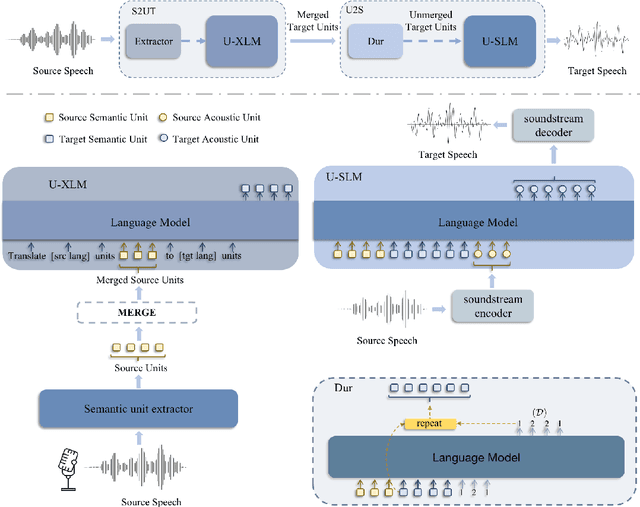
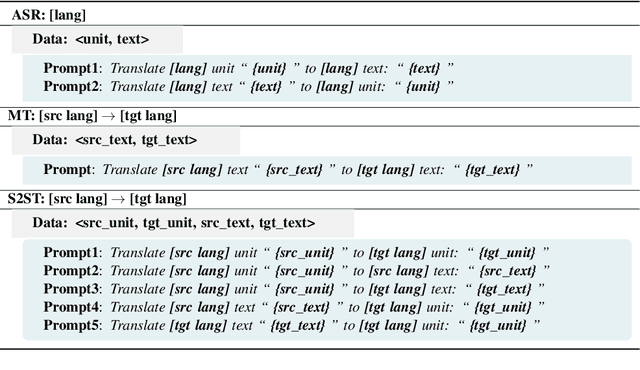
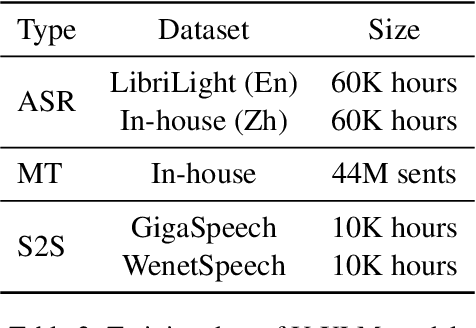
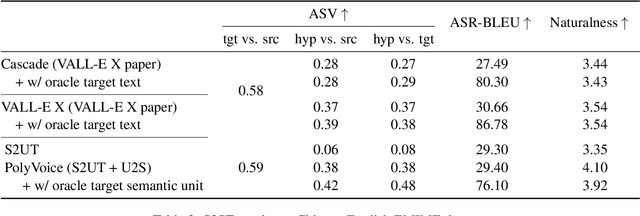
Abstract:We propose PolyVoice, a language model-based framework for speech-to-speech translation (S2ST) system. Our framework consists of two language models: a translation language model and a speech synthesis language model. We use discretized speech units, which are generated in a fully unsupervised way, and thus our framework can be used for unwritten languages. For the speech synthesis part, we adopt the existing VALL-E X approach and build a unit-based audio language model. This grants our framework the ability to preserve the voice characteristics and the speaking style of the original speech. We examine our system on Chinese $\rightarrow$ English and English $\rightarrow$ Spanish pairs. Experimental results show that our system can generate speech with high translation quality and audio quality. Speech samples are available at https://speechtranslation.github.io/polyvoice.
Parameter-Efficient Conformers via Sharing Sparsely-Gated Experts for End-to-End Speech Recognition
Sep 17, 2022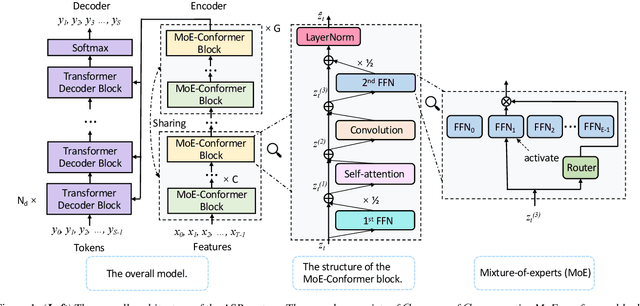


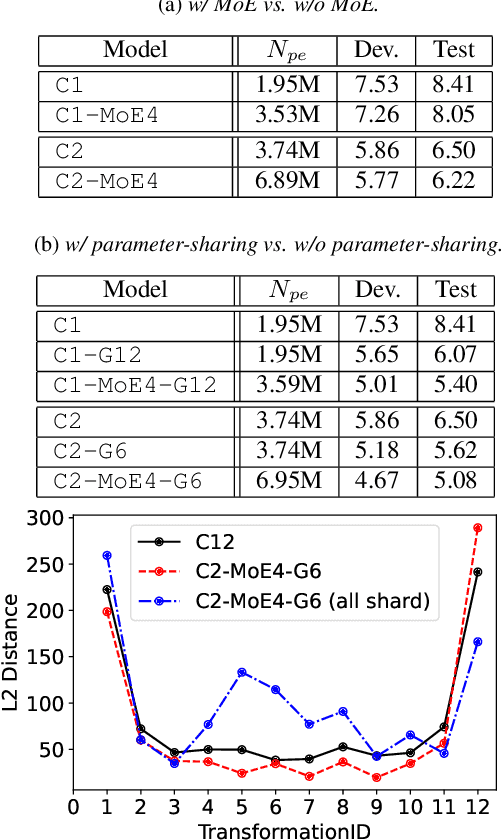
Abstract:While transformers and their variant conformers show promising performance in speech recognition, the parameterized property leads to much memory cost during training and inference. Some works use cross-layer weight-sharing to reduce the parameters of the model. However, the inevitable loss of capacity harms the model performance. To address this issue, this paper proposes a parameter-efficient conformer via sharing sparsely-gated experts. Specifically, we use sparsely-gated mixture-of-experts (MoE) to extend the capacity of a conformer block without increasing computation. Then, the parameters of the grouped conformer blocks are shared so that the number of parameters is reduced. Next, to ensure the shared blocks with the flexibility of adapting representations at different levels, we design the MoE routers and normalization individually. Moreover, we use knowledge distillation to further improve the performance. Experimental results show that the proposed model achieves competitive performance with 1/3 of the parameters of the encoder, compared with the full-parameter model.
 Add to Chrome
Add to Chrome Add to Firefox
Add to Firefox Add to Edge
Add to Edge